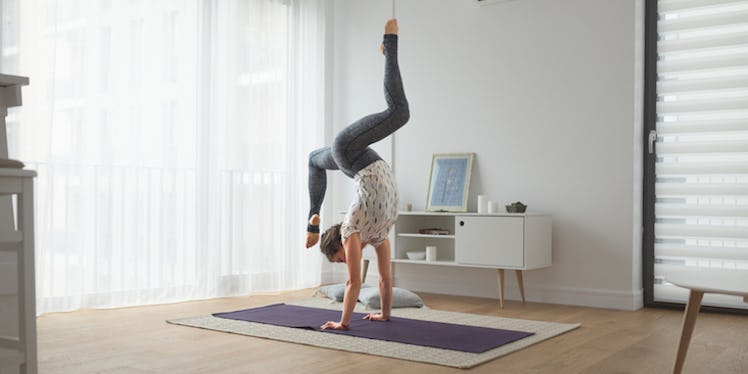
Here's How To Protect Your Wrists During Complex Poses In Your Yoga Flow
One of the most common yoga injuries complained about by beginner yogis and advanced practitioners alike is wrist pain. It's pretty understandable when you think about it, since you're constantly bearing weight on your hands during your time on the mat, which isn't something you typically do in everyday life. But if the discomfort has gotten so bad for you that you're now wondering whether yoga is just bad for your wrists in general, allow me to put your mind at ease.
The short answer is no, yoga isn't bad for your wrists. Yoga is an ancient practice meant to heal your body and mind. Of course, just because it possesses restorative powers, doesn't mean that you can get away with being mindless while bearing weight onto sensitive joints.
Your wrists are a small, but complex body part that include several ligaments and a little joint head that rotates. It's relatively easy to compress the wrist joint when it comes into contact with the bone in your forearm, and the surrounding muscles aren't strong enough. This can leave you more susceptible to injury, especially if your wrists are underused during long hours typing on a keyboard, or overused by improperly executing arm balances during your favorite vinyasa class.
As a yoga teacher, I almost always get one or two people in the room complaining of wrist pain that's exacerbated by frequent downward dogs and chaturangas. (And TBH, I've been one of those people myself!)
But it doesn't have to be this way, my friends. Here are six ways to protect the delicate joints in your wrists every time you step onto your mat, and how to deal with injuries should they arise.
01Warm Up Your Wrists Before Each Practice
Warming up your wrists before each yoga practice is an important part of protecting your wrists and preventing injuries. If you don't take a couple of minutes before your yoga flow to give your wrists some TLC, they could be holding unnecessary tension that would not go well with all of the weight you're putting on your hands during a typical flow.
Try moving your wrists in circles to encourage healthy blood flow in that area, and then extend your arms and pull down on your outstretched fingers for a deeper wrist stretch. Try to do this before every practice, and include other stretches if your wrists feel especially tight, or if you're going to be attempting more complex arm balances.
02Strengthen Your Wrists So That Weight Bearing Becomes Easier
A lot of people think that simply stretching their wrists will do the trick, and they'll be ready to dive into a sweaty yoga flow with ease. However, strengthening your wrists is just as (if not more) important as flexibility, and it a plays a huge role in preventing wrist pain.
Be sure to include wrist-strengthening exercises in your everyday routine if you know that your wrists typically act up during yoga, or if you want to start venturing into the world of handstands and crow poses.
03Be Mindful To Evenly Distribute The Weight In Your Palms
Whether you're in tabletop position, plank pose, or downward facing dog, evenly distributing your body weight onto all parts of your palm is key if you want to avoid placing too much pressure on one part of your wrist.
Try to avoid bending your fingers, and really press them down into the mat. Make sure you're not placing too much weight on the heel of your palm, and that you're focusing on your pointer fingers, as this will create a balance of wrist-friendly equilibrium.
04Spread Your Fingers Wide In Downward Dog
Downward facing dog is a pose that's very frequently returned to during a typical yoga flow, but it can be a huge culprit of wrist pain if it's not done correctly.
Make sure that your fingers are spread really wide, like a starfish, so that you're evenly distributing weight onto your palms, rather than dumping everything into your wrists.
Additionally, try revolving your inner biceps outward while bringing your outer triceps inward during your down dogs. This will add strength and alignment to your asana, and it'll provide relief to your wrists.
05Include Core Exercises In Your Routine
It always comes back to the core, doesn't it? Seriously, it's true: Having a strong core will do wonders in preventing wrist injuries during your yoga practice.
According to Yoga Journal, having a strong core helps your rotator cuff muscles work more efficiently, which in turn strengthens and stabilizes your shoulders. All of this basically translates to less pressure on your wrists and a happier, pain-free yogi in the long run. Do that core work, friend! Trust me, it pays off.
06Listen To Your Body, And Back Off Whenever Necessary
If you're taking all of the correct measures to protect your wrists, but you're still experiencing pain or discomfort during your flow, it's probably your body's way of telling you to back off.
Honor the signals you're receiving, and focus on strengthening your core, trying out a no-wrist flow, taking some time off to rest, or you can even try attending more restorative classes until the inflammation ceases and you begin to heal. Yoga is all about meeting your body exactly where it is, and some days, that might just mean staying off your wrists.
Namaste and happy flowing!